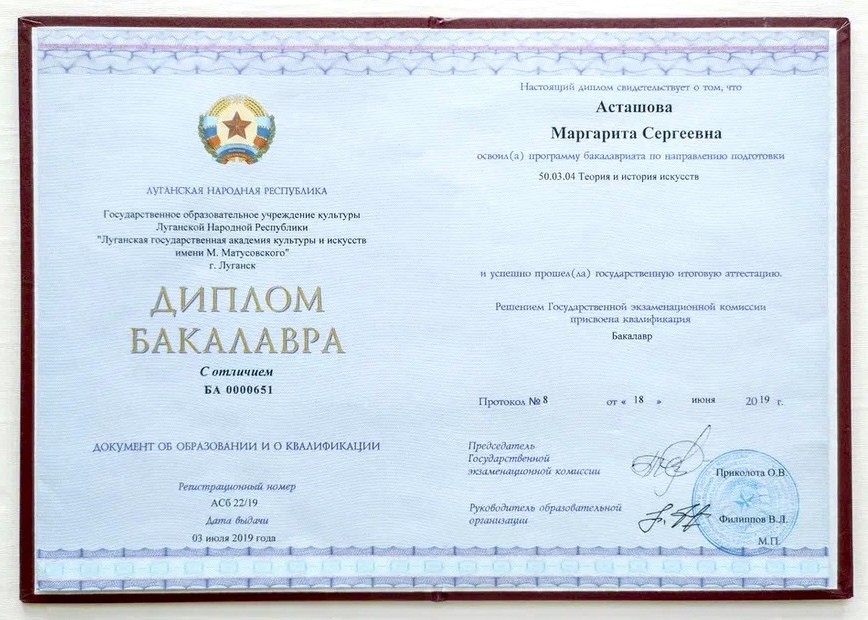Realistic Watercolor Botany PRO
with Margarita Astashova




What is the course about
This course is a comprehensive set of lessons for those who would like to master the secrets of watercolor realism in the genre of botanical illustration.
Lush buds from different turns, interesting piths, voluminous curved petals with satin velvet and glossy textures are waiting for you.
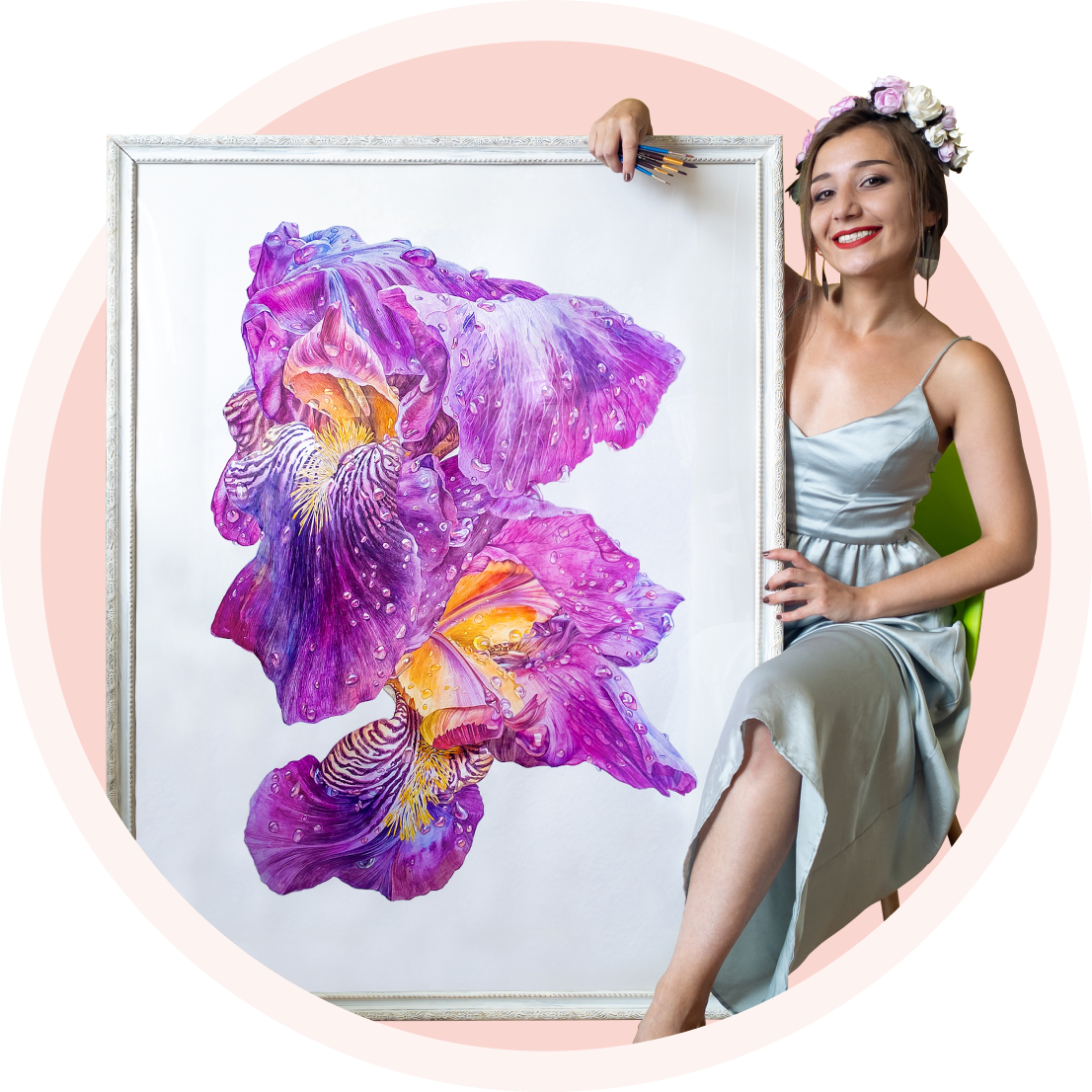
What are we going to draw
Painting from live flowers! A whole kaleidoscope of amazing plants will serve as samples for drawings, such as: lily, ornithogalum, eustoma, iris reticulata, carnation, black calla, chrysanthemum, trumpet creeper, flamingo lily, double-flowered tulip, alstroemeria, gladiolus, Cosmos, European white elm, Partenocissus, sumac, roses of several varieties.

And also...
And you'll also fill your paintings with life through a series of lessons on variegated insects, their whimsical shapes and openwork wings. Those insects include: The Hercules beetle, Romalea, Bee, Screech beetle, Swallowtail, Spanish moon moth and caterpillar of the Monarch butterfly.

Course program


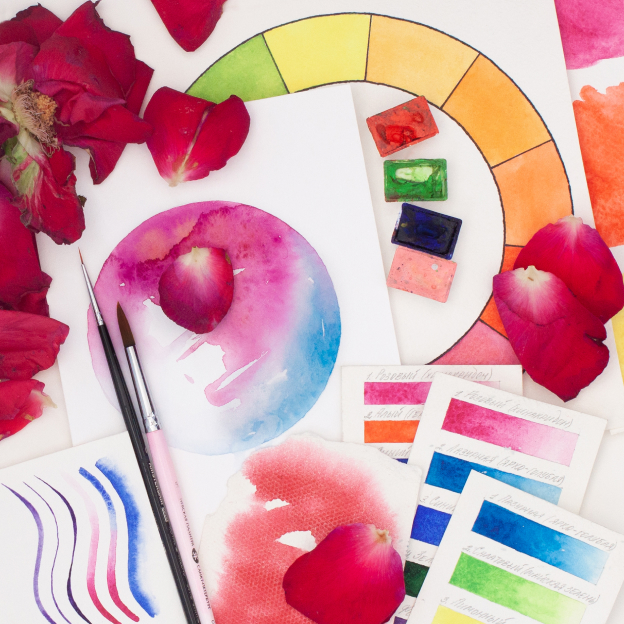
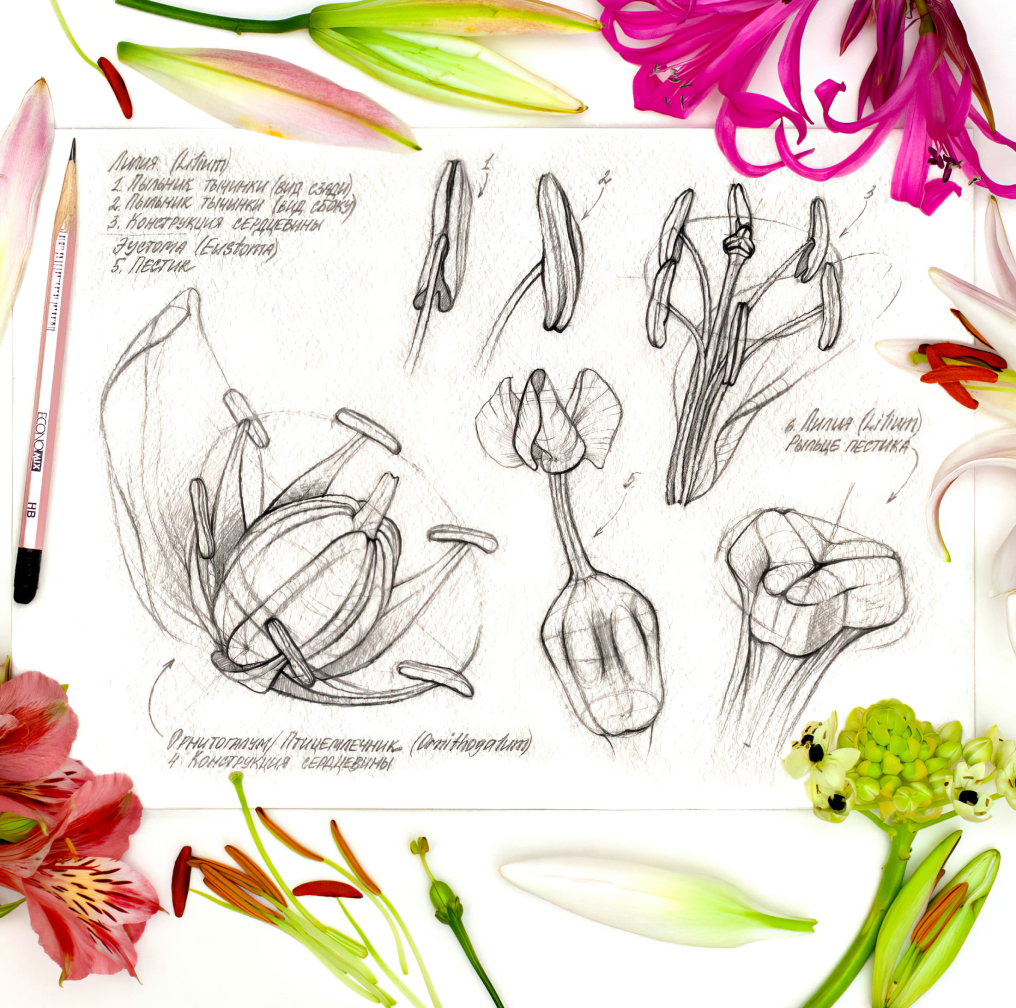
You will learn:
- how to draw the structure of anthers and stamen filaments in different turns;
- how to create a supporting frame for a drawing using the invisible axes;
- how to arrange stamen filament in a ring in spatial position based on constructive ovals;
- how such constructive ovals help form the volumes.

You will learn to:
- draw the bud as an integral three-dimensional structure;
- elaborate in detail the elements of a complex pith in color;
- create an expressive image of a light flower on white paper;
- show translucent shadows on light surfaces.
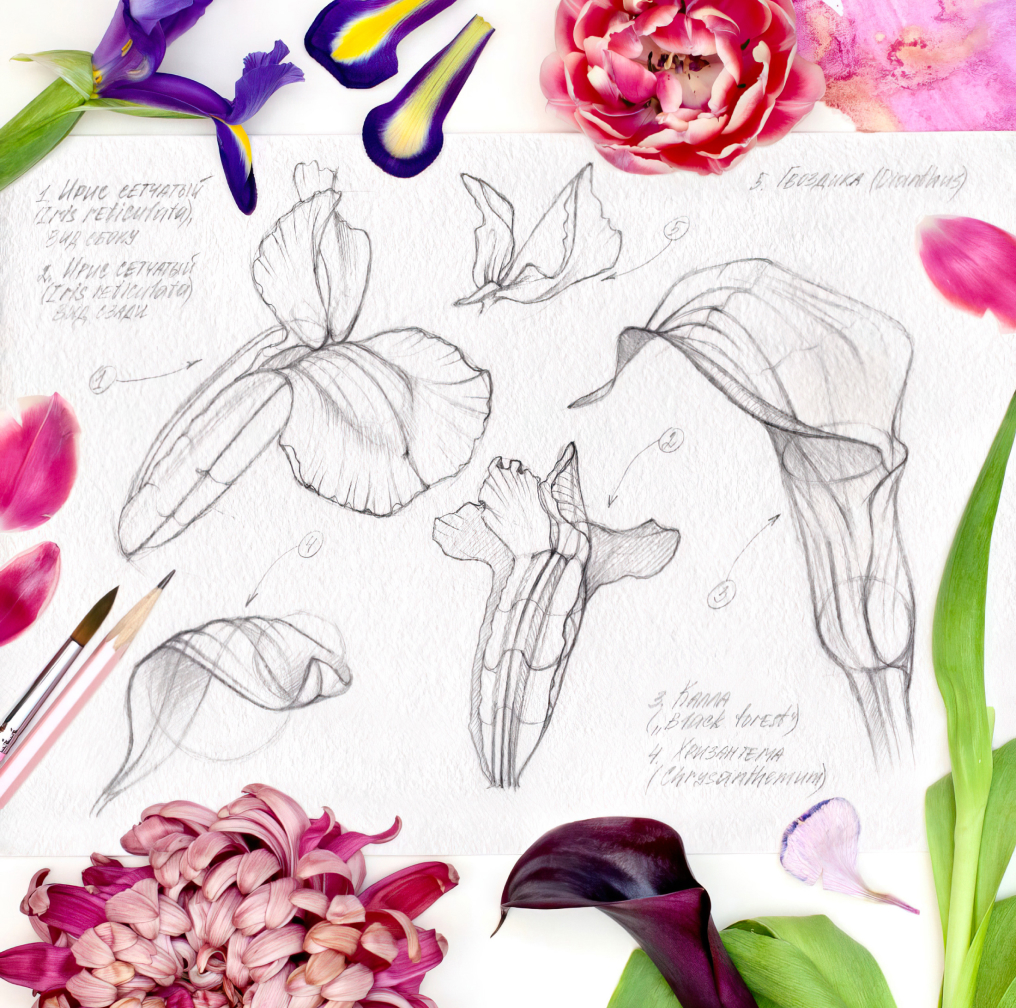
Using the example of iris reticulata, carnation, calla and chrysanthemum, you will learn to:
- convincingly draw, rather than copy, petals in complex turns;
- use auxiliary lines to convey the structure in the drawing;
- correctly form small volumetric details with a pencil.
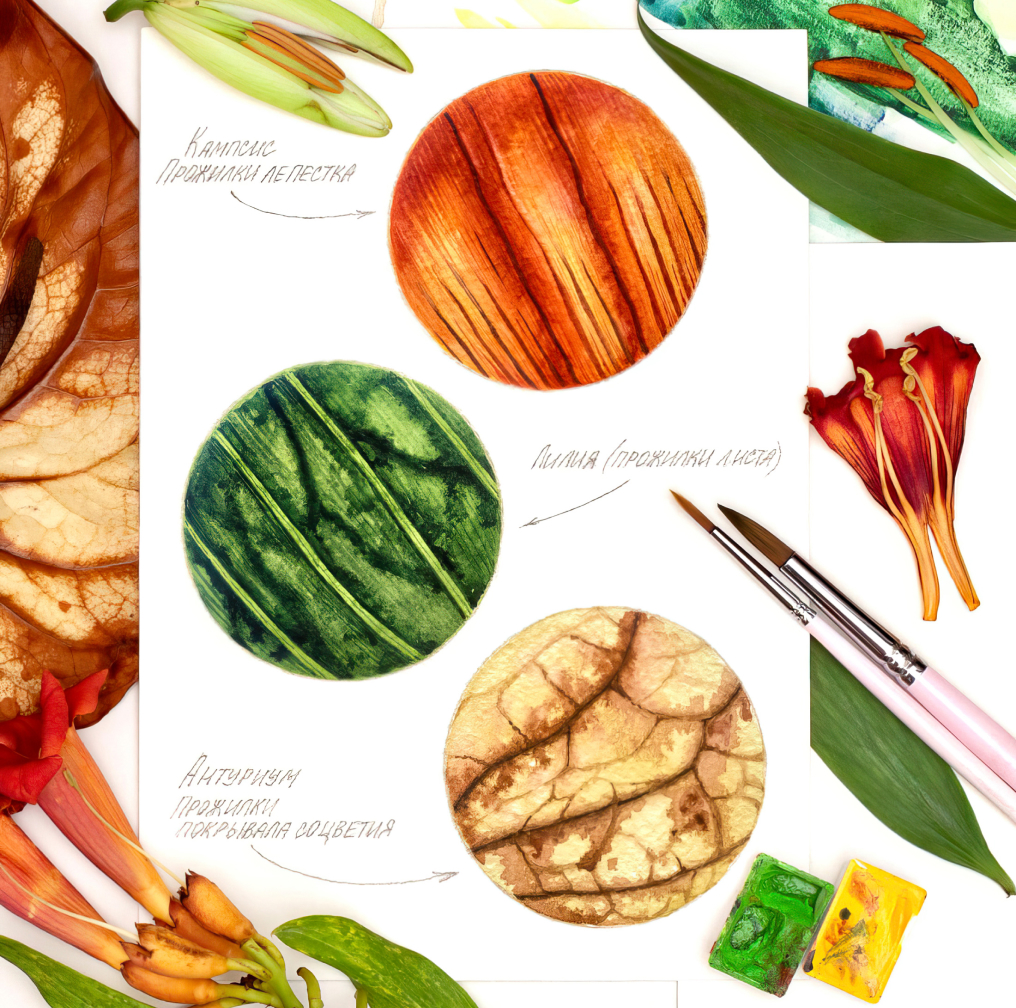
Using natural examples of trumpet creeper, green lily leaf, and the cover of flamingo lily inflorescence, you will learn to:
- imitate dark veins on a lighter background;
- paint light veins with a hard edge on the surface of plant tissue, as well as veins with a vague edge lying in the thickness of the leaf;
- elaborate the veins with a floating edge and spreading pigmentation.

Using a real tulip petal as an example, you will learn to:
- Create an active contrast of shadows and glaring, reflecting light areas;
- Paint the subdued flecks with soft borders;
- "Lay" details along the surfaces of the convex and concave sections of the petal;
- Naturally imitate the plant fibers.
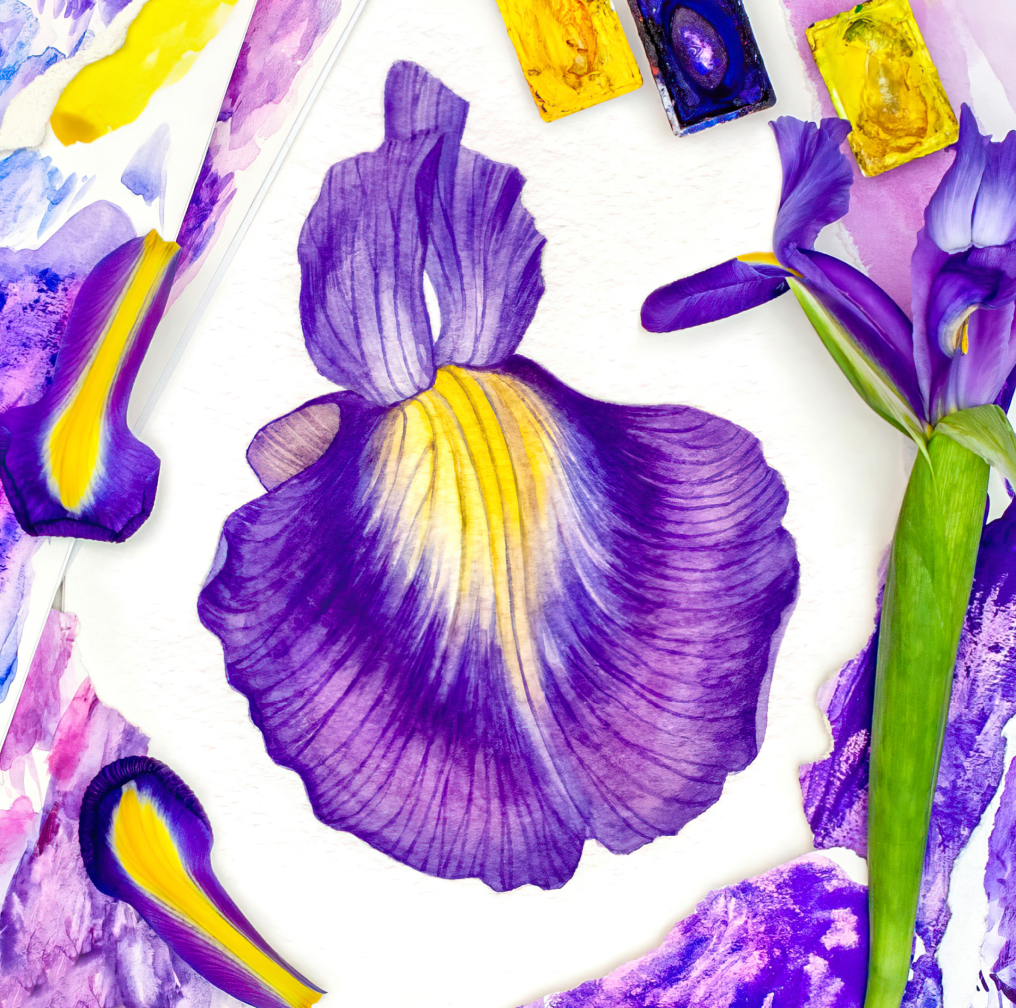
Using a real iris petal as an example, you will learn to:
- "test" the volumes of the petal with a brush, tracking the direction of growth of veins and other details, carefully "laying" them on its surface;
- delicately shade sharp boundaries of spots and details, as well as soften contrasts to achieve a velvet effect;
- use a multi-layer technique to elaborate the fine pigmentation on petals with a velvet texture.
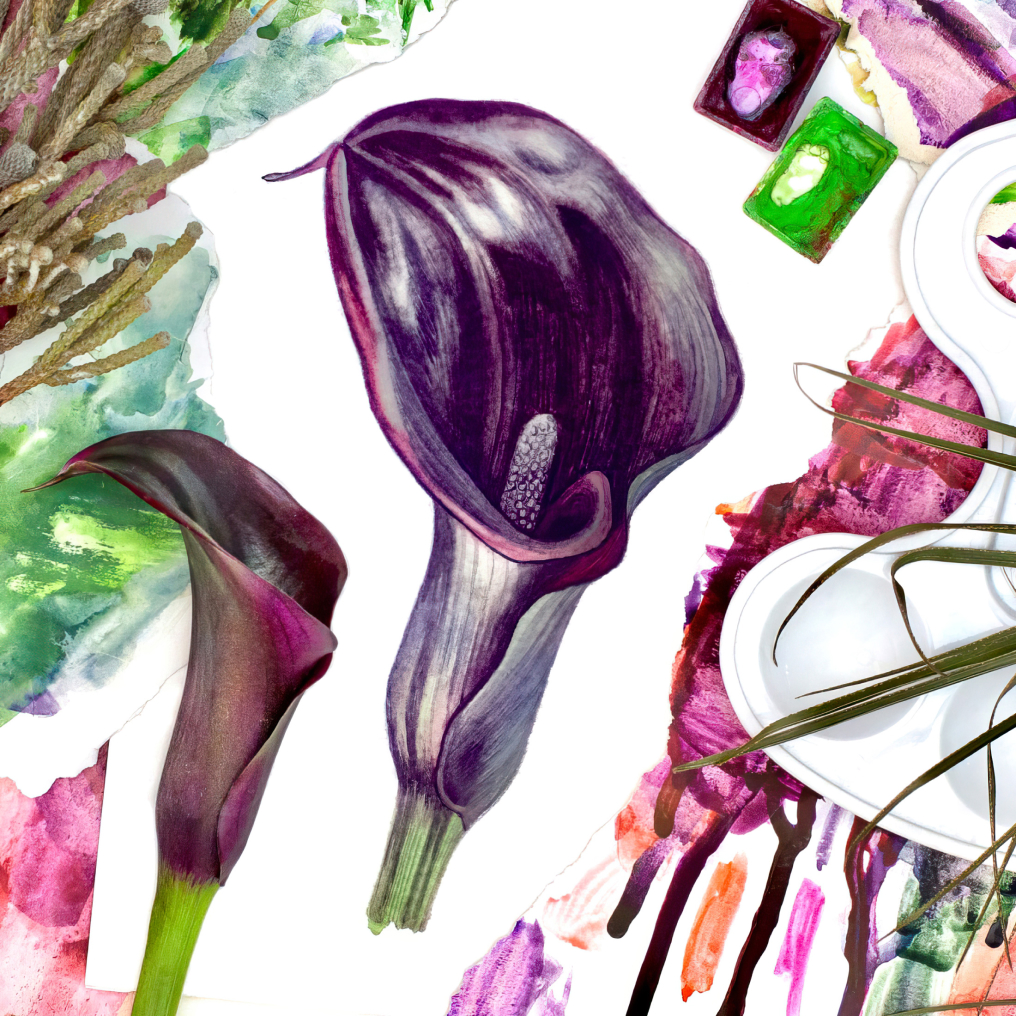
Using a natural calla bud as an example, you will learn to:
- analyze the shape with a pencil in hand and convey its volume;
- achieve active contrasts of shadows and glare surfaces;
- use different watercolor techniques to elaborate the convex and concave surfaces.
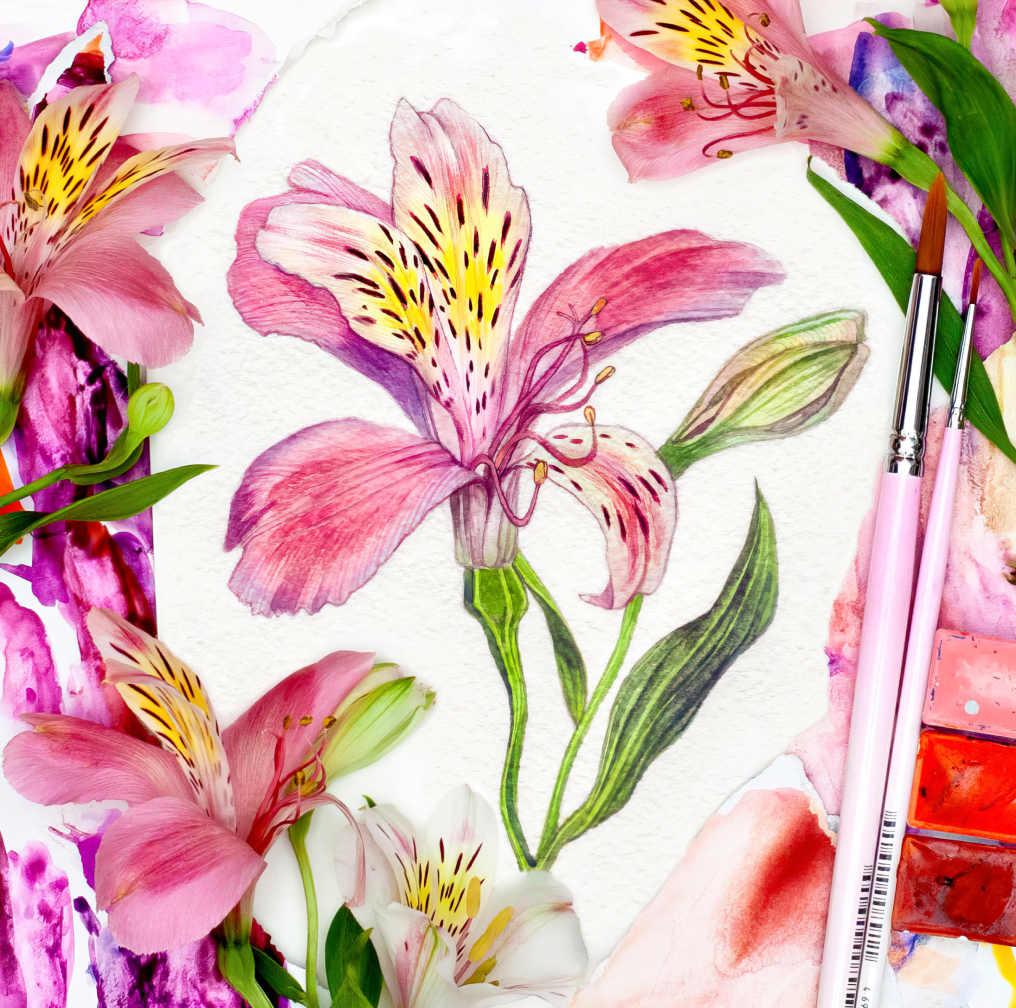
We study in details the pigmented bud. Using a live alstroemeria bud as an example, you will learn to:
- make a constructive design of the shape of a flower with a pencil, taking into account small details;
- consistently apply watercolor in layers to achieve a realistic image;
- imitate plant fibers and convey the texture of petals;
- prescribe the exotic color of a flower.
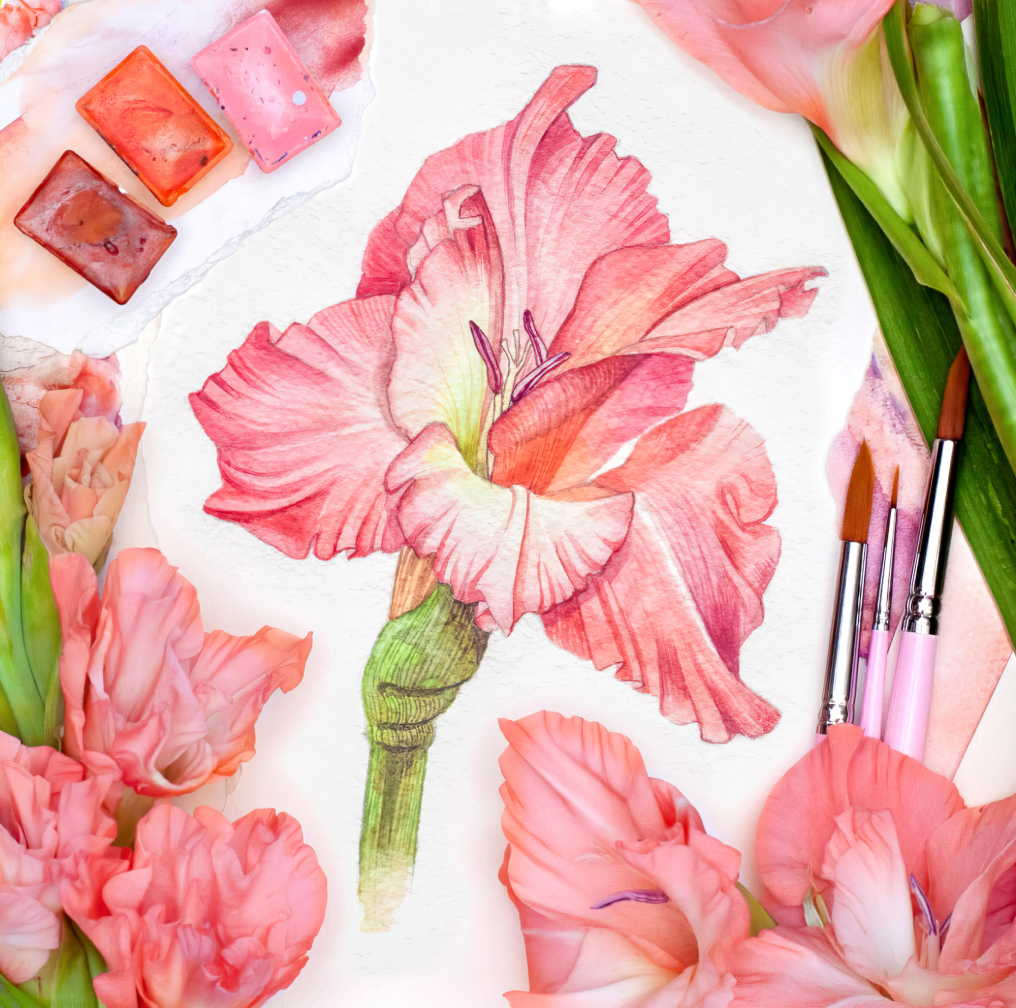
Using a live gladiolus bud as an example, you will learn to:
- mix multi-component shades to recreate the exquisite color scheme of a flower;
- delicately shade areas in small fragments;
- convey the texture of the floral surface;
- form small folds and elements of a complex pith.

Using a live eustoma bud as an example, you will learn to:
- analyze and convincingly construct with a pencil a complex design of a bud with a large number of petals;
- step by step apply watercolor layers and make soft shading;
- elaborate the texture using a hatching technique in the direction of fiber growth;
- delicately emphasize the contours;
- form shadows in accordance with the volumes of the shapes.
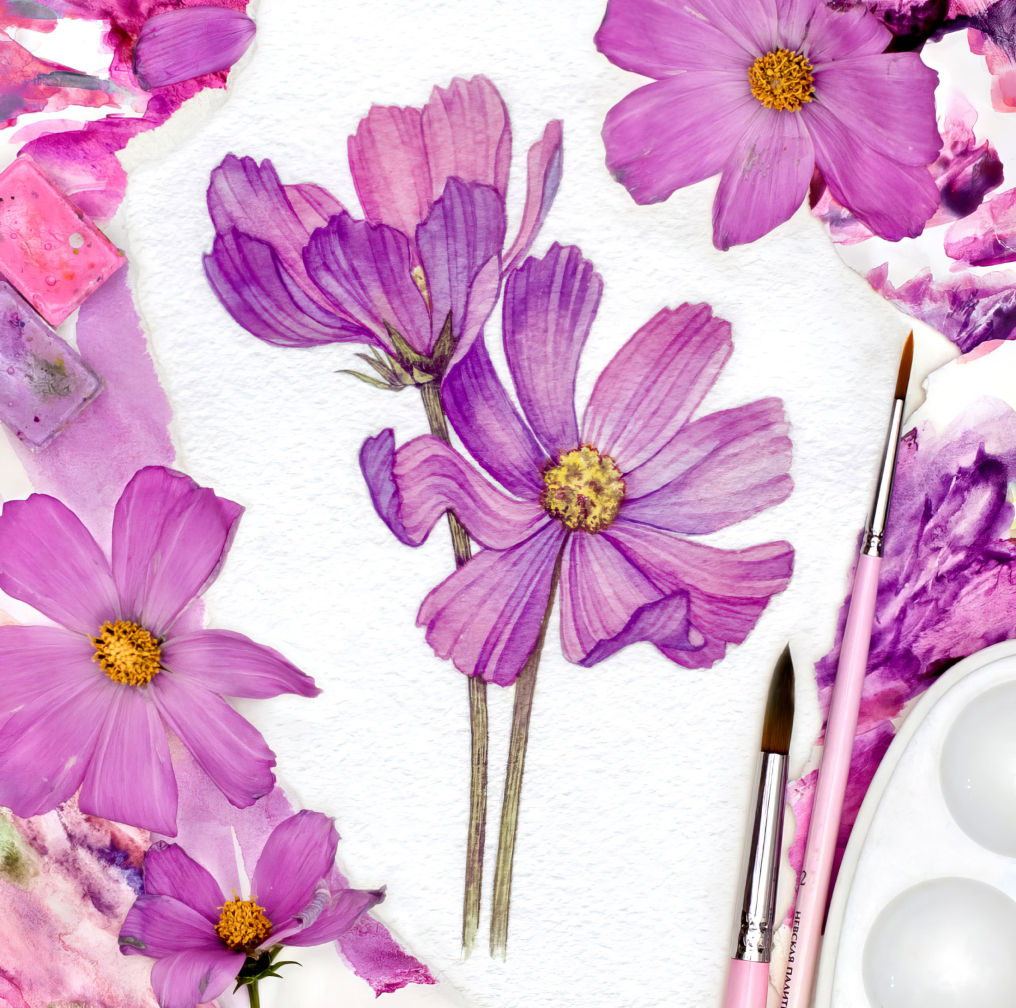
Using a natural Cosmos bud as an example, you will learn to:
- perform constructive design of buds in different turns;
- convey light and shadow on the petals in a delicate color scheme;
- imitate the texture of the Cosmos pith;
- choose warm and cold shades;
- draw small folds on the surface of the petals.

A branch of the European white elm, a branch of creeper with berries, and its vine will serve us as natural specimens. You will learn to:
- draw voluminous curved leaves, form convincing curls of the back surfaces at different angles;
- correctly depict their jagged edges;
- convincingly fix the berries on the leafstalk;
- carefully outline the ornate, tangled vines in the drawing.
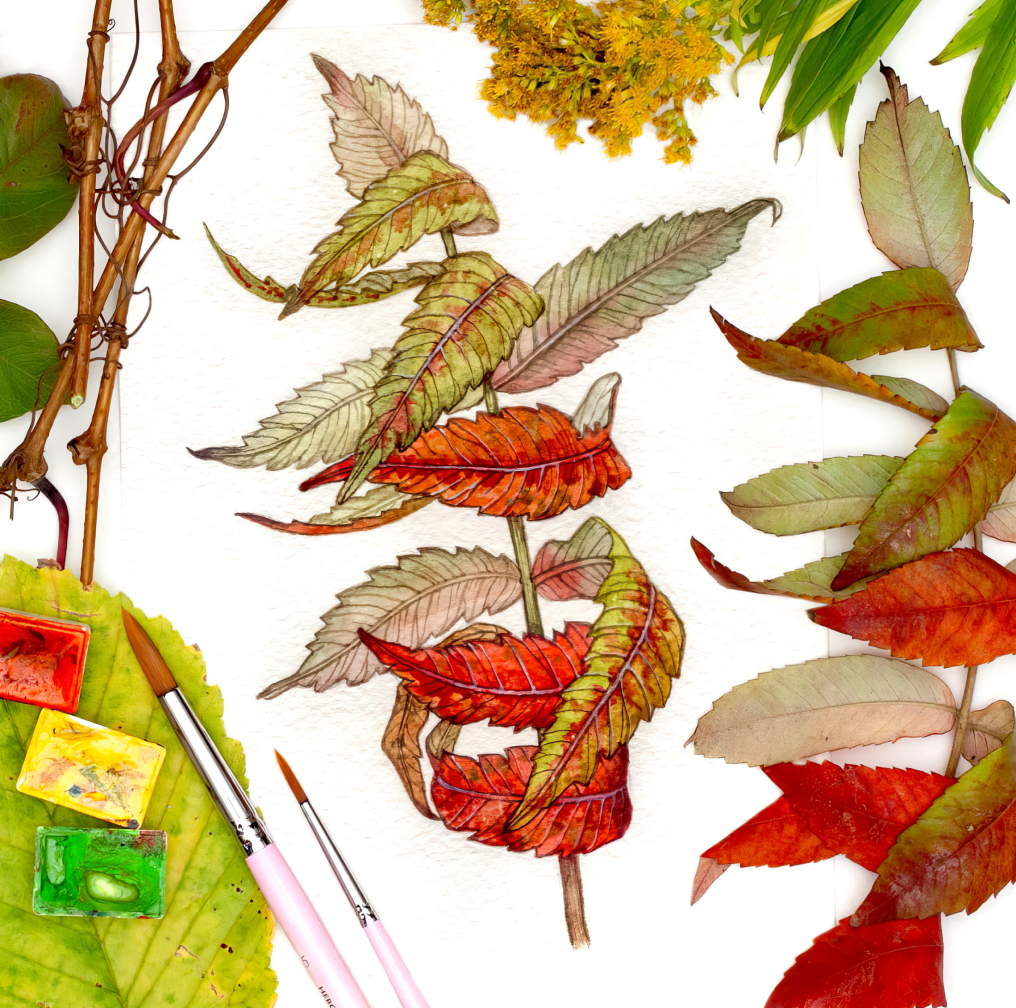
Using a sumac branch as an example, you will learn to:
- convincingly make a pencil drawing of a complex leaf structure with elements from different views;
- mix complex shades and create pigmentation in wet-on-wet technique;
- draw an openwork grid of veins with a thin brush.

Using the example of drops on a red rose bud, you will learn to:
- make the drop streamlined, insert details along its surface;
- create active contrasts;
- paint details in wet-on-dry and wet-on-wet techniques
- choose warm and cool shades to recreate the light inside the drops.
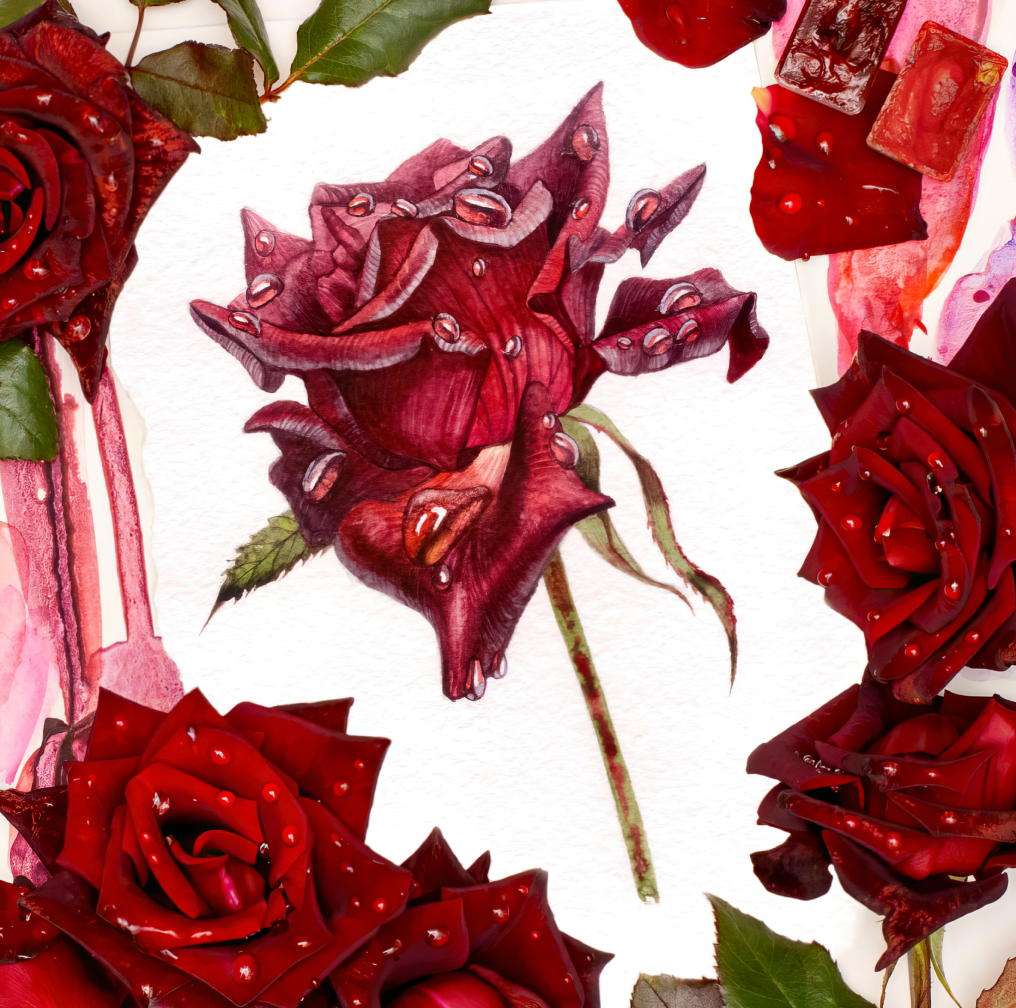
Using a live red rosebud as an example, you will learn:
- step-by-step construction of a complex flower shape with a pencil;
- to place the dew drops on the surface of the petals, taking into account their slants and bends;
- to mix shades in a wide range of reds;
- to coordinate the color scheme of the flower and the shades of the drops so that they were visually perceived as a single whole;
- to work with the masking fluid.
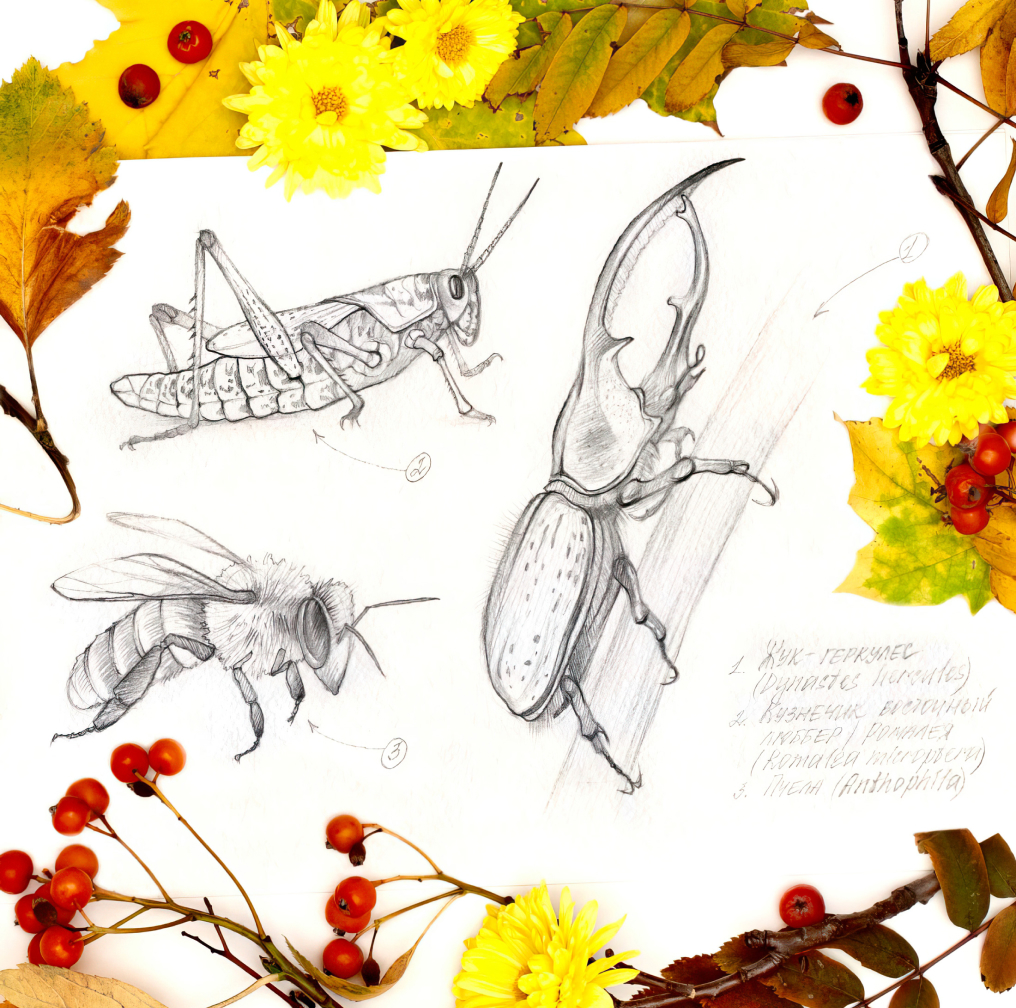
You will learn:
- how to depict an insect from thin antennas to sharp claws in a realistic manner;
- how to imitate a hard carapace and soft fibers in a sketch with light furs;
- how to draw insects from different angles;
- in what sequence to perform the drawing so that it did not seem academical and took into account all the structure features
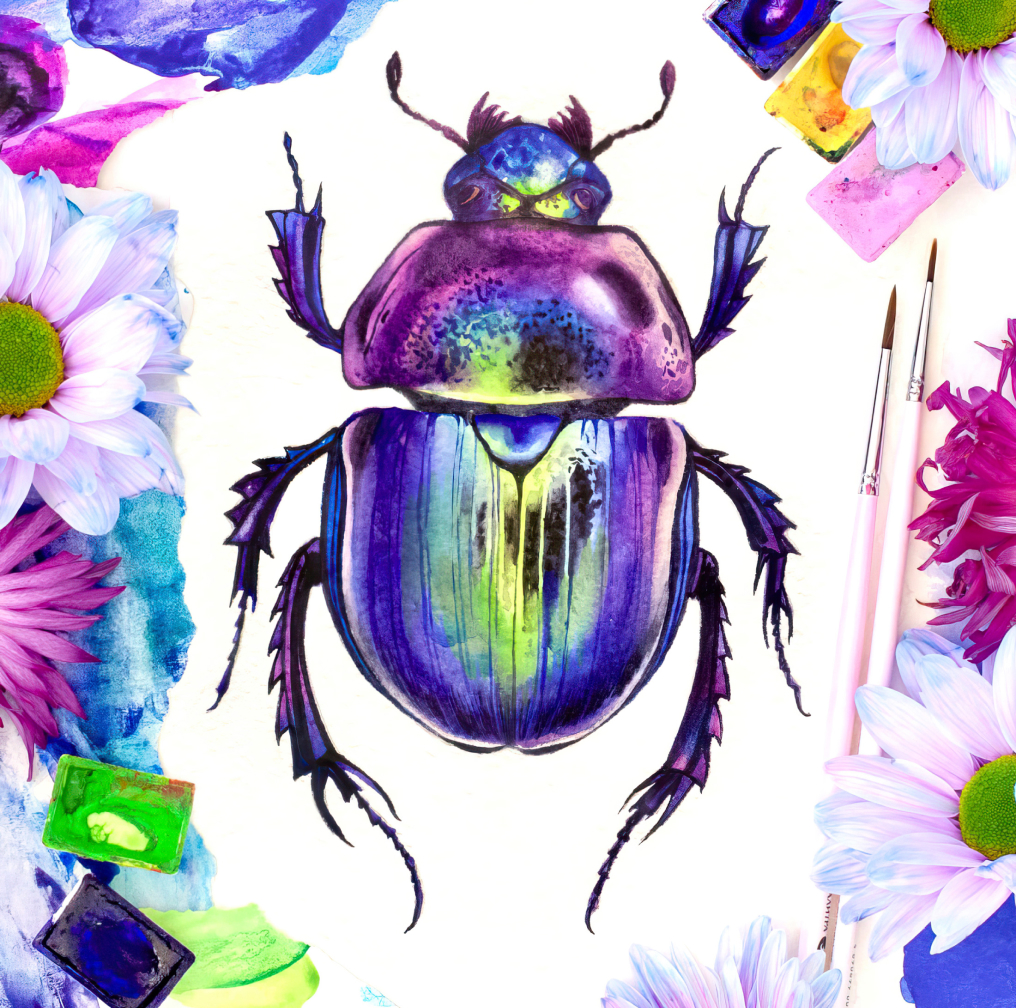
You will learn to:
- Build a pencil drawing from simple to complex, from general to specific;
- Apply watercolor consistently and in multiple layers and mix shades in their variegated combination;
- Show overtones and deep shadows;
- Refine details (ribbed and porous surfaces, as well as sharp claws);
- Consolidate the skill of delicate, soft shading.
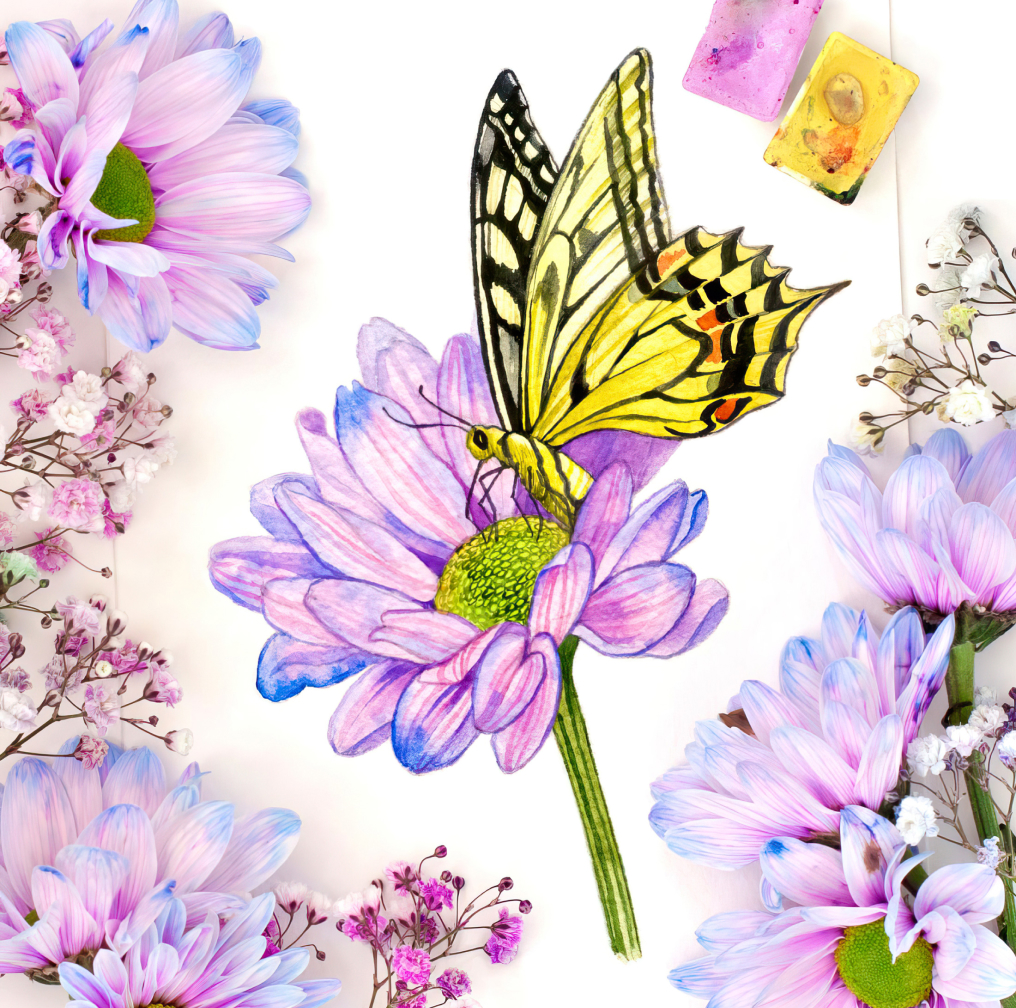
You will learn to:
- consistently draw a three-dimensional flower with a large number of petals;
- Imitate uneven pigmentation and delicate veins using various techniques;
- recreate the variegated color of insect wings.
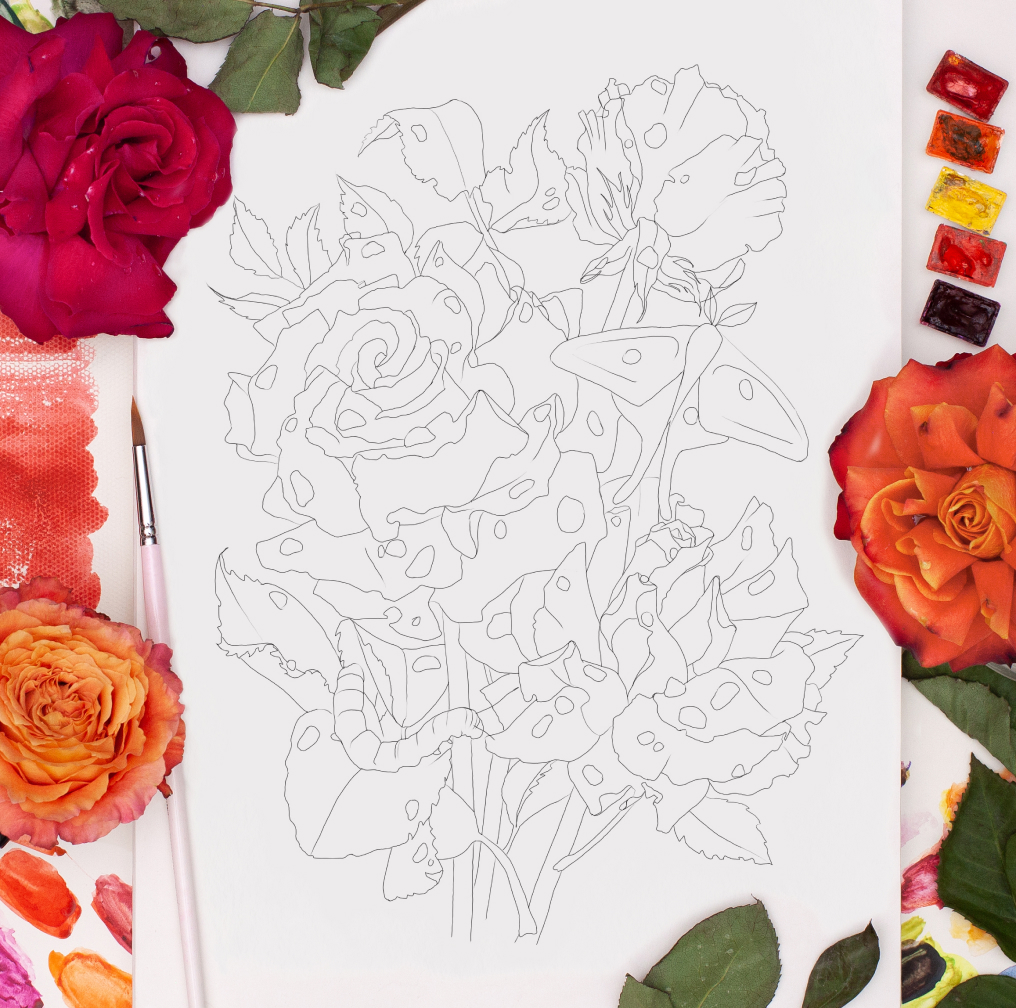
In the final series of lessons, we will start a multi-component composition and will move from an ordinary illustration to A3 picture. In this lesson you will learn to:
- Form a balanced composition from elements of different properties;
- Consistently construct complex shaped objects with a pencil;
- Work with the masking fluid.

In this lesson you will learn:
- mixing complex shades;
- delicate stumping of color spots;
- imitation of texture on the surfaces of petals;
- formation of light and shadow in watercolor.

In this lesson, using Isabella's Peacock Eyes and a flexible butterfly caterpillar of the Monarch butterfly as an example, you'll learn how to:
- draw insects with a pencil;
- convey the natural coloring with watercolors step by step;
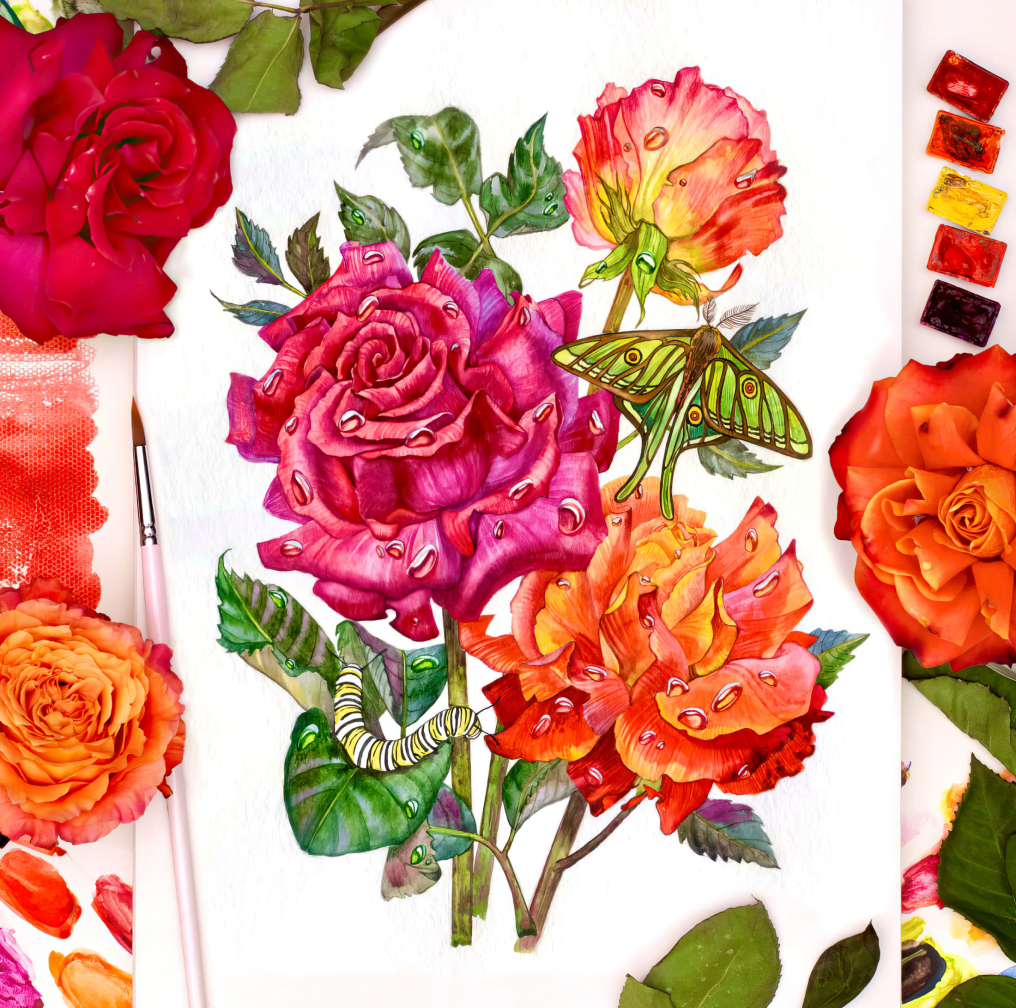
In this lesson you will learn to:
- mix complex shades to elaborate the upper and back surfaces of the leaves;
- paint shadows with soft edges and thin veins;
- recreate overtones on the surface of leaves, taking into account the color scheme of flower buds.
Feedback from our students

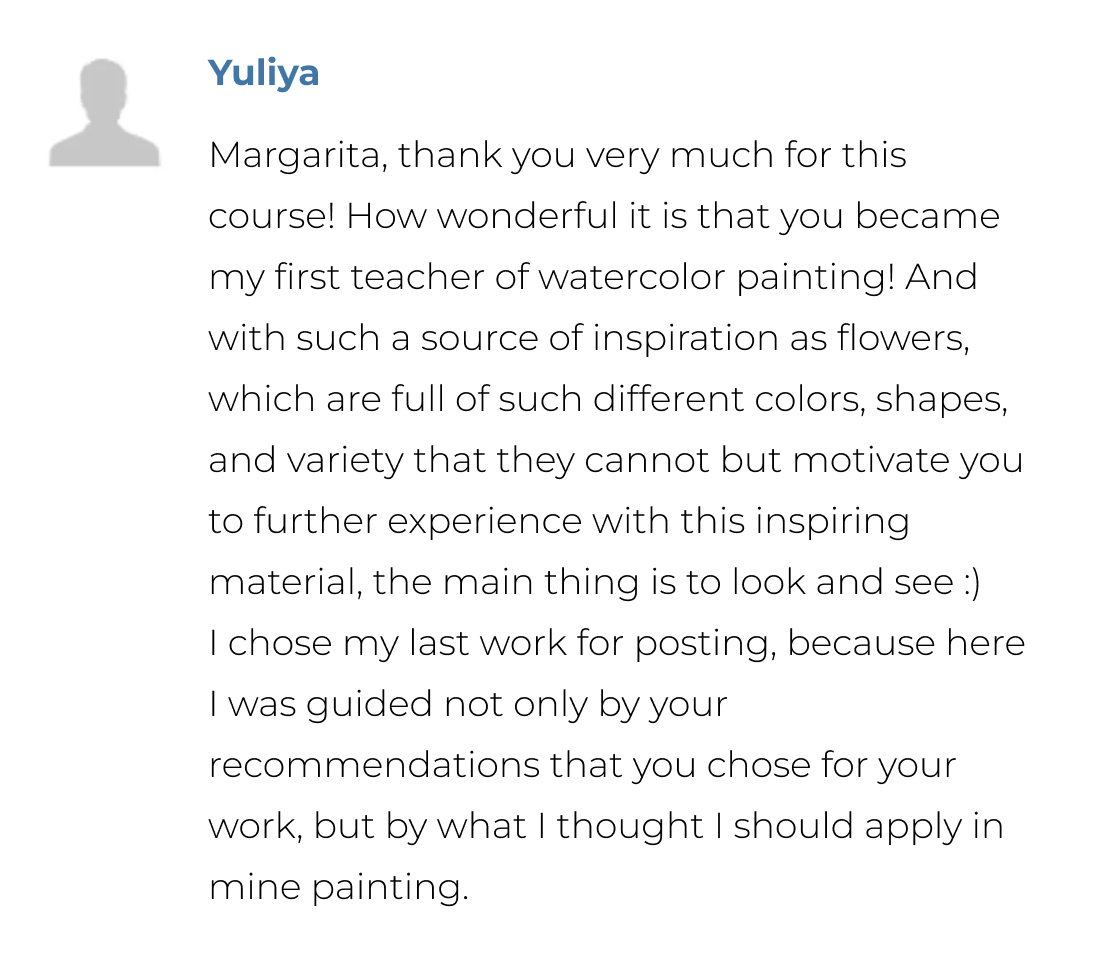



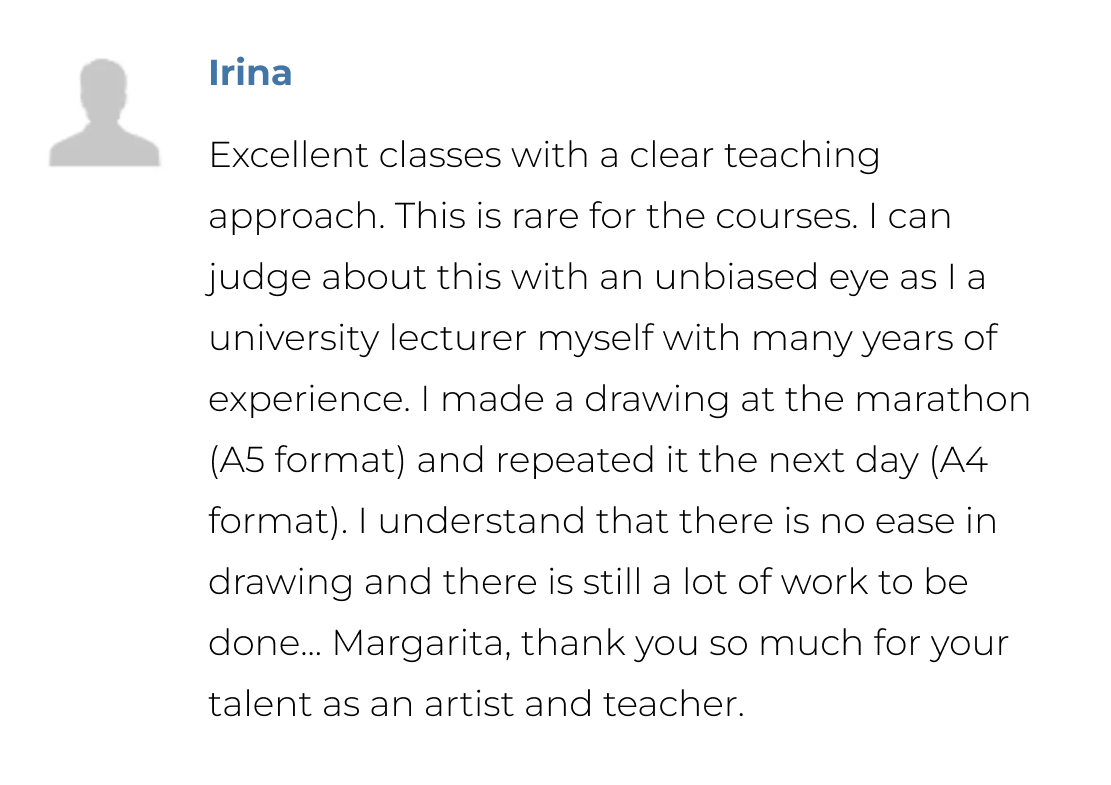



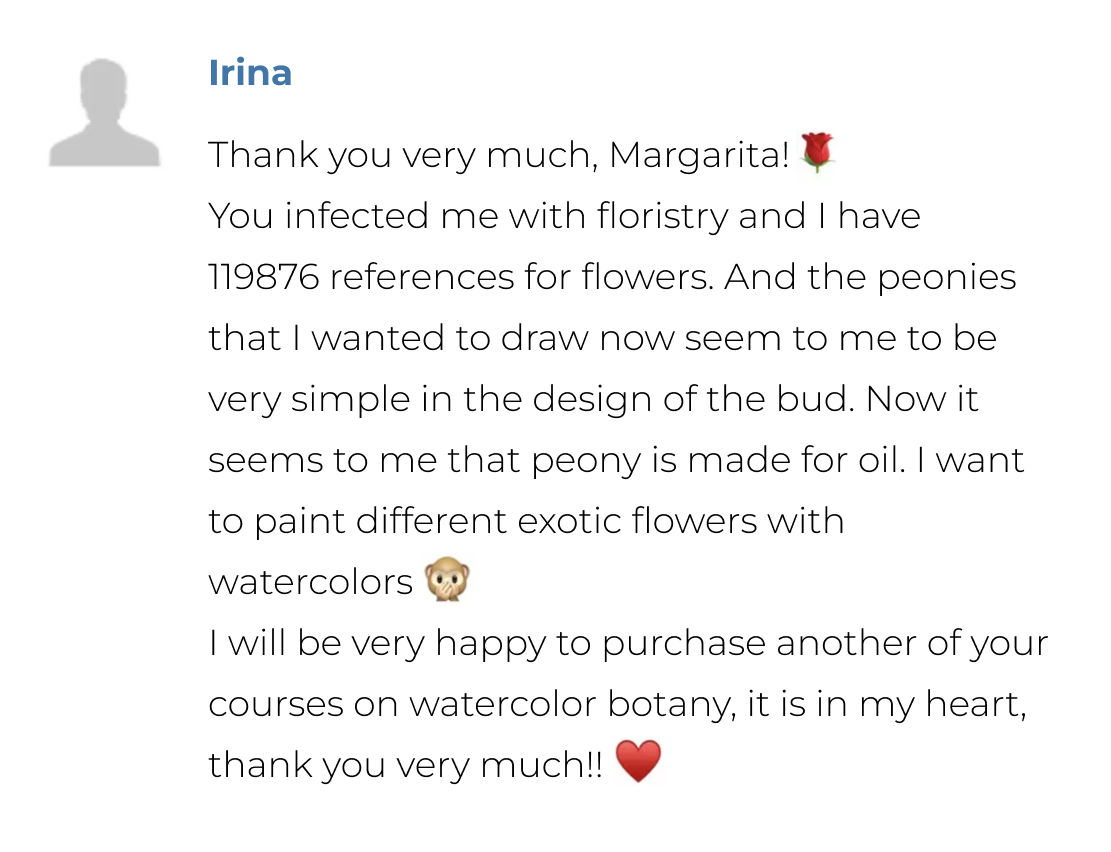
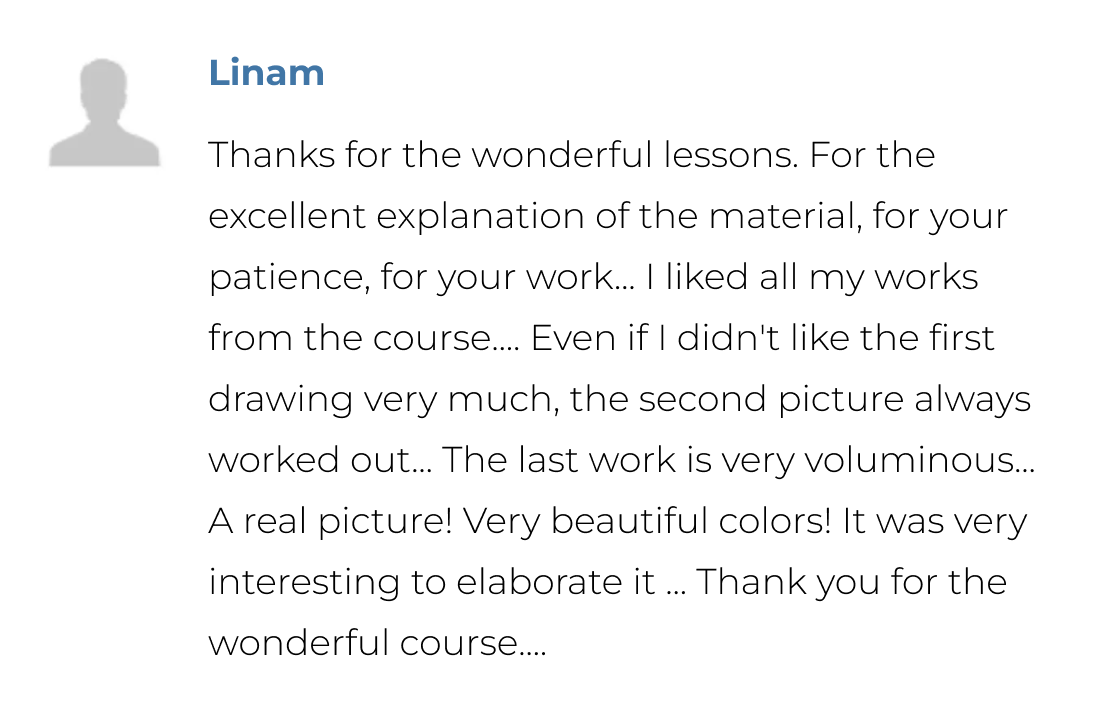

Materials
- Watercolor paper in A5 (for botanical illustrations), A4 (for pencil sketches) and A3 (for the final composition) formats; density 300 g/m, 100% cellulose
- Plain pencils (softness: H, HB), eraser
- Watercolor paints (I recommend purchasing the shades "Pink Quinacridone" and "May Green" in addition to the set)
- Palette (I use coated cardboard as a palette, or plastic, or ceramic)
- Brushes No. 5, No. 2, No. 1 (optional No. 0), round, with a sharp tip, preferably soft synthetic
- A container of water, a piece of cloth for drying brushes
- Masking fluid

Choose your participation option
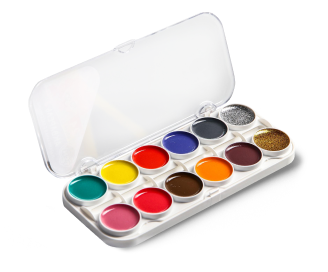
I Draw It Myself
- 14 illustrations, 4 botanical sketches, 1 realistic painting
- 25 lessons: from sketch illustrations to an A3 painting
- Machine translated subtitles: English, German, French, Italian, Spanish, Greek, Polish, Portuguese, Hungarian, Chinese, Indonesian
- «Unfreezing the course»
- Ability to view comments on students' drawings
- Lifetime access to the course
- Checking Your Drawings 60 Days
- Face-to-face one-hour online consultation with a course expert
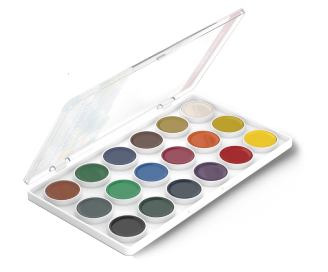
With Support
- 14 illustrations, 4 botanical sketches, 1 realistic painting
- 25 lessons: from sketch illustrations to an A3 painting
- Machine translated subtitles: English, German, French, Italian, Spanish, Greek, Polish, Portuguese, Hungarian, Chinese, Indonesian
- «Unfreezing the course»
- Ability to view comments on students' drawings
- Lifetime access to the course
- Checking Your Drawings 60 Days
- Face-to-face one-hour online consultation with a course expert
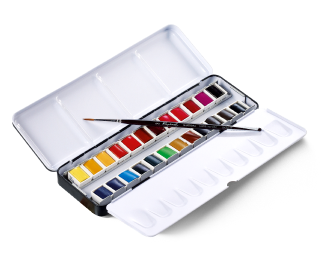
VIP
- 14 illustrations, 4 botanical sketches, 1 realistic painting
- 25 lessons: from sketch illustrations to an A3 painting
- Machine translated subtitles: English, German, French, Italian, Spanish, Greek, Polish, Portuguese, Hungarian, Chinese, Indonesian
- «Unfreezing the course»
- Ability to view comments on students' drawings
- Lifetime access to the course
- Checking Your Drawings 60 Days
- Face-to-face one-hour online consultation with a course expert
Margarita's works
So why do students choose to study at the Drawing Dog school?


After graduation, access to the course in many schools is closed and renewal is possible only for an additional fee.
With the Drawing Dog you can revisit the course an unlimited number of times, the course remains with you indefinitely on any tariff!

Students at individual study tariffs are often left alone with the lessons and may abandon the course. With the Drawing Dog, you can watch reviews of other students' works and get feedback on your drawings from the school community.
There are no "dry" answers on feedback tariffs. We don't respond with "Good" or "Well done" – we will always find something to praise or something that you can improve.

We appreciate our students and give bonus rubles for the purchase of new products to those who are already studying with us! For your convenience, discounts will be applied automatically when you enter your email address.
Course Materials

- Watercolor paper in A5 (for botanical illustrations), A4 (for pencil sketches) and A3 (for the final composition) formats; density 300 g/m, 100% cellulose
- Plain pencils (softness: H, HB), eraser
- Watercolor paints (I recommend purchasing the shades "Pink Quinacridone" and "May Green" in addition to the set)
- Palette (I use coated cardboard as a palette, or plastic, or ceramic)
- Brushes No. 5, No. 2, No. 1 (optional No. 0), round, with a sharp tip, preferably soft synthetic
- A container of water, a piece of cloth for drying brushes
- Masking fluid
Frequently Asked Questions
- > MY LEVEL OF DRAWING IS A BEGINNER. WILL I BE ABLE TO DO IT SO BEAUTIFULLY?
-
To master a realistic drawing, you need to divide it into stages. Understand the principles of bud design, the sequence of watercolor techniques, the elaboration of details that are responsible for realism.
You are going to enjoy the technique of step-by-step mastering of these principles. During the course, we will gradually immerse ourselves in the topic, acquiring the necessary skills. And at each stage you will have a result - paintings in graphics and watercolor sketches. When you move on to the "Realism" section, you will already have an understanding and skills of how to draw it beautifully. So I'm sure you can do it!
- > HOW LONG WILL THE WAY FROM SKETCH TO REALISM TAKE?
-
If you have a no-feedback plan, it will all depend on your personal pace at which you take the lessons.
On feedback tariffs, we are actively engaged in lessons during two months from the moment you "unfreeze" the course.
In general, I recommend taking the course slowly. Enjoy the process and results (pictures) more at each stage of learning.
- > HOW WILL THE FEEDBACK ON MY DRAWINGS BE ARRANGED?
-
At the end of the lesson, you post a photo of your work. The teacher will have an opportunity to leave textual, graphic (notes on the drawing), as well as audio comments to your work.
At the bottom of each lesson, there will be a comment block where you can ask any questions about learning.
- > IS THE COURSE SUITABLE FOR CHILDREN AND TEENAGERS?
-
The course is suitable for junior artists from 13 years old, with the support of an adult and at a leisurely pace. Botanical illustrations are a calming process that trains perseverance. Like knitting, beadwork, embroidery.
Didn't find an answer to your question?
Write to us



